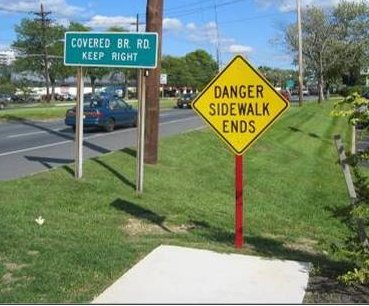
Picture of Route 70 in Cherry Hill, by Andrew Smith.
We were delighted to learn last month that the Trenton City Council unanimously approved a Complete Streets policy for the City of Trenton, which is an important step towards making Trenton’s streets safer for all users — drivers, pedestrians, and cyclists alike. Trenton joins the fellow Mercer County towns of Lawrence, Princeton Borough, Princeton Township, and West Windsor, all of whom have passed Complete Streets resolutions.
Currently, Monmouth County is the only county in the state that has passed a county-wide Complete Streets resolution, but that could be on the verge of changing. As noted on the blog of our friends at the West Windsor Bicycle Pedestrian Alliance, the adoption of a Complete Streets policy was discussed at the April 10th Mercer County Freeholders meeting, and a resolution was drafted for consideration. The discussion will continue at the next Freeholders meeting — Tuesday April 24 at 6:30pm at the McDade County Building in Trenton. If passed, Mercer County will be the second county in the state to adopt a Complete Streets policy!
Complete streets are designed and operated to enable safe access for all users – pedestrians, bicyclists, motorists and transit riders of all ages and abilities. Instituting a complete streets policy ensures that agencies think about, design, and operate rights of way to enable safe access for all users. In their Complete Streets Policy, the NJ Department of Transportation recognized these benefits of complete streets:
- Complete Streets improve safety for pedestrians, bicyclists, children, older citizens, non-drivers and the mobility challenged as well as those that cannot afford a car or choose to live car free
- Provide connections to bicycling and walking trip generators such as employment, education, residential, recreation, retail centers and public facilities
- Promote healthy lifestyles
- Create more livable communities
- Reduce traffic congestion and reliance on carbon fuels thereby reducing greenhouse gas emissions
- Complete Streets make fiscal sense by incorporating sidewalks, bike lanes, safe crossings and transit amenities into the initial design of a project, thus sparing the expense of retrofits later
There is often some confusion about what is involved in the adoption of a Complete Streets policy. Some towns shy away from touching the issue out of fear that such a policy will make everything more expensive, or force them to retrofit all of their current streets for bikes and pedestrians. In reality, however, embracing transportation access for all users of our transportation system is a process that can happen over a very long time period. It can be done gradually, with simple measures, using existing funds.
Interested in learning more about Complete Streets or getting your community interested? GMTMA can help. Additionally, some good web resources include the National Complete Streets Coalition and New Jersey Department of Transportation. Furthermore, Complete Streets can be a way to get certified by Sustainable Jersey, a program that provides certification and funding to “green” municipalities. The program awards points toward certification to municipalities that adopt their own complete streets policies (guidelines here).
